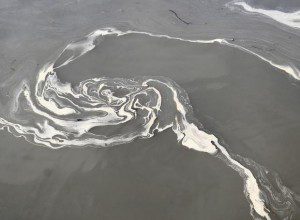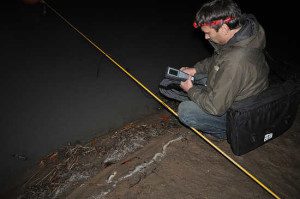This may seem a little far-fetched, but for the second time in a month, coal processors have dumped large quantities of toxic waste into rivers that supply drinking water to the public.
 On February 3rd  a pipe released an estimated 27 million gallons of toxic waste water and 82,000 tons of coal ash into the Dan River from a Duke Energy coal processing facility in Eden, North Carolina. Flowing through eight NC and eight Virginia counties, the river is the primary source of drinking water for several communities; Danville, Va., a city 20 miles downstream was first to be affected, as the water changed hue to an opaque, concrete gray color, with a creeping sludge covering the bottom of the river.
On February 3rd  a pipe released an estimated 27 million gallons of toxic waste water and 82,000 tons of coal ash into the Dan River from a Duke Energy coal processing facility in Eden, North Carolina. Flowing through eight NC and eight Virginia counties, the river is the primary source of drinking water for several communities; Danville, Va., a city 20 miles downstream was first to be affected, as the water changed hue to an opaque, concrete gray color, with a creeping sludge covering the bottom of the river.
The water is safe for consumption according to city and state officials:
“It was an issue we had to accommodate,†said Barry Dunkley, water director for the city of 43,000. “It created a lot of turbidity, and it won’t settle out so the filters are doing the work.â€
Appalachian Voices, an environmental advocacy non-profit based in Boone, N.C., says that pronouncement may be premature, and has posted photos of their teams on site conducting water testing here. Greenpeace has also posted aerial and onsite photos here.
 Coal Ash is known to contain heavy metals including mercury, selenium as well as poisonous substances such as arsenic, 1/3 of the Period Table, according to scientists at Appalachian Voices. Matt Wasson, Ph.D., Director of Programs for the group, found a 6-12 inch layer of coal ash blanketing the bottom of the river two miles down from the spill site:
Coal Ash is known to contain heavy metals including mercury, selenium as well as poisonous substances such as arsenic, 1/3 of the Period Table, according to scientists at Appalachian Voices. Matt Wasson, Ph.D., Director of Programs for the group, found a 6-12 inch layer of coal ash blanketing the bottom of the river two miles down from the spill site:
“A big rain could easily wash large amounts of this downriver, so Danville’s water supply is not out of the woods yet.â€
Wasson also said that while the filtration system may produce water safe for human consumption according to State standards, most damage to humans will probably be due to arsenic and heavy metals in the fish that eat contaminated microscopic organisms and the insect larvae in a process that increases levels of toxins each step along the food chain.
 A separate coal-related chemical spill into the Elk River in West Virginia on January 9th resulted in unusable public water across nine counties and impacted 300,000 residents for several days, prompting a state of Emergency to be declared. The National Guard was called in and police had to manage distribution of bottled water, which disappeared from retail outlets in the wake of the disaster.
A separate coal-related chemical spill into the Elk River in West Virginia on January 9th resulted in unusable public water across nine counties and impacted 300,000 residents for several days, prompting a state of Emergency to be declared. The National Guard was called in and police had to manage distribution of bottled water, which disappeared from retail outlets in the wake of the disaster.
To understand how such a disaster might impact the local hospital’s ability to continue operations in case of a poisoned water supply, we spoke with Craig Fulcher, Associate Director of Operations for Danville Regional Medical Center, which serves the area. When asked about the plans to handle this type of emergency, Mr. Fulcher was very confident of the center’s ability to manage through a crisis based on a 2012 event when the hospital went off the public water supply completely for four days, in response to a flood that disrupted public water:
“We have pipes coming out of the building where tanker trucks can back up, connect, and immediately provide a secondary supply of potable water safe to drink, bathe and perform other necessary functions…we have mutual aid agreements with multiple sources to ensure there is an adequate supply.â€
This offers some comfort that Emergency Management plans and preparation can help mitigate the increasingly dangerous environment posed by the chemicals and transportation of toxic materials, particularly by rail, in the Energy sector.





0 Comments